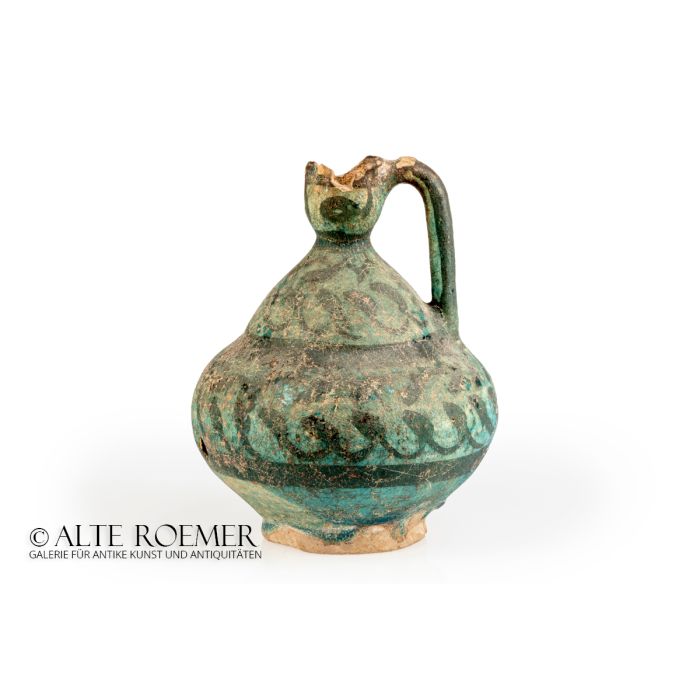Persian jug from Sultanabad
€1,040
available
Object number
AR3119
| Object: |
Persian jug from Sultanabad
|
| Material: |
Beige clay with turquoise glaze and black paint.
|
| Period: |
Late 13th century AD. Time of the Mongolian rule in Iran. Ilkhanate. |
| Description: |
Jug with one handle. Pear-shaped body with a flattened base, slightly tapered at the waist and more tapered at the neck. The round handle runs in a loop from the lip and then straight down to the shoulder. Remarkable is the beautiful turquoise glaze with band and wave ornaments painted in black.
|
| Background: |
The impressive pottery is from Sultanabad in today's Iran. Typical are the thick walls and the black painting on the turquoise glaze.
|
| Dimensions: |
20cm height, 15cm diameter.
|
| Condition: |
Approx. 10mm hole at the belly, approx. 3/4 of the lip broken off and missing, the glaze on the handle chipped. The rest of the body is complete and intact. The glaze does not reach all the way to the foot, which has been the case already at the time of creation and does not represent later damage. The glaze is covered with fine cracks, this craquelé impressively underlines the age of the vessel. Parts of the surface and the inside of the neck have developed an iridescent patina.
|
| Provenance: |
Acquired by us on the British art market in 2020. Previously in the British private collection of Antony John Scammell. Acquired by him on the British art market between 1968 and 1971. A letter dated 28 April 1971 from the Royal Victoria and Albert Museum in London to Mr Scamell is available. In it, the Curator of the Ceramics Department, R.J. Charleston, attributes and dates the jar as mentioned above and sends back a photo of it. There is also a note from 1968, which describes that an enclosed fragment of paper with handwriting was stuck to the bottom of the vessel under a layer of dust. It could be a fragment from the time the jug was made and used. Antony John Scammell (1937 to 2019) is from Bristol and became interested in the history of Rome and Great Britain at an early age. In the 1950ies he began buying Greek, Roman and British coins and building a collection. In the 1960ies his focus widened to include artefacts from the Mediterranean and Asia Minor, from antiquity to the Islamic period. His collecting activities reached a peak in the 1980ies. Until the end of his life in 2019, Mr. Scammell was active in maintaining and expanding his collection. |
| Authenticity: |
We unconditionally guarantee the authenticity of every artefact, all items are subject to our lifetime return policy on authenticity.
|


